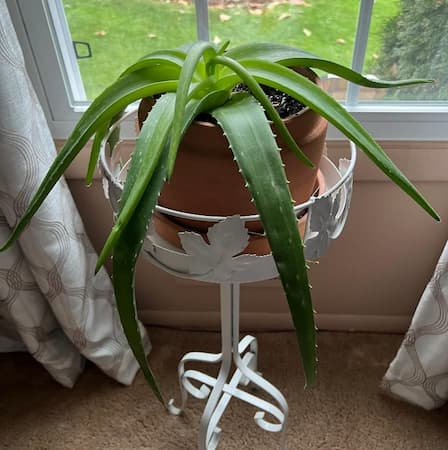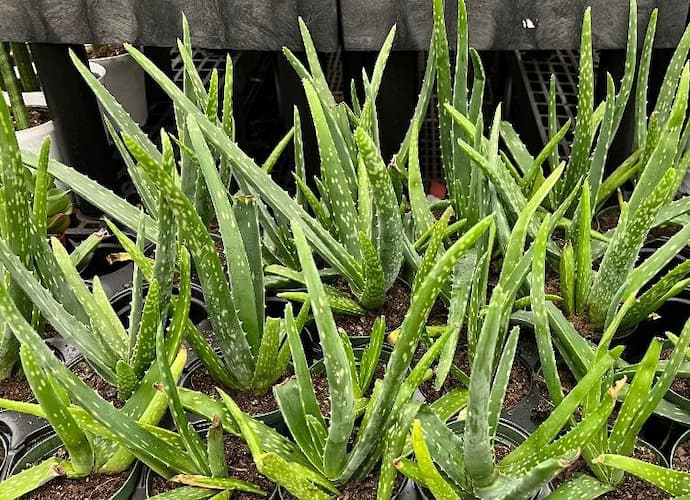How to Grow Aloe Vera Plants

About Aloe Vera Plants
Ahhh, aloe vera! It’s cool. It’s soothing. It moisturizes. You will find it in topical medicines, lotions, soaps, and more. There are many health benefits of aloe vera plants, too. Many of us grow aloe vera houseplants. They grow well indoors in your home or office. Native to Africa, there are hundreds of varieties of Aloe plants. Depending upon variety, these plants can grow as small as an inch. The most common indoor varieties grow several inches to a foot tall.
Aloe Vera plants are very popular, and often grown as indoor houseplants. They are easy to grow, yet slow-growing. The plant takes 3 to 4 years to reach just 12 inches tall. You need to be patient to see them in bloom. It takes four years for the first bloom. But, it then usually blooms annually. It lives for about 12 years. They look great in containers by themselves or mixed in with other houseplants.
The thick, heavy leaves are filled with sap that you can harvest. And yes, you can use the soothing sap (oil or juice) in them.
Did you Know? The sap from some aloe vera plants is edible. Use the juice in teas and beverages. However, some varieties are poisonous. Importantly, do not use aloe vera juice for internal consumption, if you do not know which ones are non-toxic.
Aloe Vera Plant Specifications
Flower Colors: Orange, red, and yellow.
Flowers Bloom: Mid-Summer outdoors.
Plant height: Twelve to twenty-four inches tall.
Light Requirements: Full sun to partial sun.
Ideal Soil pH: 5.5 – 8.5.
Toxic?: It can be toxic to humans and pets if consumed incorrectly.
Deer Resistant? Generally, yes.
Hardiness Zones: 10 – 12
Plant Type: Perennial
Native To: Africa
Botanical Name: Aloe barbadensis miller
Number of Species: Over 400.
Other Names: Aloe Vera plants are also called Burn Plants and African Lily.
Are Aloe Vera Plants Edible?
YES!! and NO!!
Some varieties are toxic. And only the inside gel is edible. And, only when properly prepared. There is a layer of latex between the skin and the gel. It is latex, which can cause serious side effects. In high amounts, it can even be fatal.
Aloe gel has a clean and refreshing flavor. Try it in a variety of recipes, including salsa and smoothies.
Caution: Because of the toxicity of some parts of the plant, we recommend you do not make home remedies unless you are trained to properly and safely do so.

Health Benefits of Aloe Vera
The many health benefits of Aloe Vera gel have been known for thousands of years. Harvest for use, by removing a large stem or stalk from the plant with a sharp knife. Then, simply squeeze out the sap. Usually, Aloe Vera juice is made into a gel for topical treatment for a variety of medicinal applications. They include topical treatment for:
- Burns
- Rashes
- Itchy skin
- Poison ivy
- Dry, cracking skin
- Skin moisturizer
- Accelerate healing of wounds
- Prevent wrinkles
Internal medicinal uses of non-toxic varieties include:
- Relieves digestion.
- Reduce constipation.
- Lower blood sugar.
- Reduce Dental plaque which can lead to tooth decay.
- Treat canker sores

Light Requirements
When grown outdoors, Aloe Vera plants grow best in direct sunlight. Look for a planting location where they will receive six to eight hours of direct sunlight and a little light afternoon shade.
Indoors, Aloe Vera houseplants are adaptable. Place them in or near a window where they can get bright, indirect sunlight for laarge portion of the day.
Aloe Vera Plant Propagation
Aloe is propagated by offshoots from the mother plant. Simply remove baby plants and repot them in separate containers. This is by far, the most common propagation method.
Also, the leaves of the plant can be planted in moist soil to root. Make sure to keep the soil moist for several weeks to allow the roots of the new plant to develop.
The seeds from flowers can also be harvested for propagation. However, it takes longer to produce new, plants of any size.
Aloe Vera Plant Care and Maintenance
Aloe is an easy to grow indoor houseplant. Caring for these low maintenance plants is a cinch.
Select a pot or container that fits your room decor. It should have holes in the bottom for good drainage.
Aloe plants prefer full sun. But, they tolerate a light shade.
Plant roots spread wide, but are shallow in the soil. Water thoroughly. Allow the soil to dry between watering.
Our only complaint about this great plant, is it can become top heavy and fall over, uprooting itself from the soil. Its shallow roots, make it difficult to anchor in the soil. Decorative staking is helpful.
Fertilize once every month or two, for best growth. Or, use fertilizer spikes.
If you are going to grow Aloe plants outdoors, treat it as an annual. It will succumb to frost and freeze. Protect the plant from cold and frost. Or, bring it indoors in cold weather.
Did You Know? It is sometimes called the “Plant of Immortality” as it can grow without soil.
Pruning Aloe Vera Plants
Aloe vera plants need little or no pruning. Remove any sick or dead leaves with pruning shears. Cut the leaf off at the main stem. Sometimes, the tip of the leaves turns brown. You can cut these off, too.
Insects and Plant Disease
You may find an occasional problem with mealy bugs, scale, and aloe mites. Treat the plant with insecticidal soap as soon as you spot these pests.
Deer usually leave the plant alone. They do not like the spiky leaves.
Rust and fungal diseases can occur in cool temperatures and high humidity. Prevention is the best treatment. For Aloe Vera houseplants, adjust to the environmental conditions.
Overwintering Aloe Vera Plants
Aloe Vera is not a cold-hardy plant. It succumbs to frost and freezes. So, bring your plants indoors for the winter and grow them as a houseplant.
In warmer climates, cover them up overnight with a blanket, hot cap, or even a bucket.
Related Articles
Please support our site. Shop for:
- rmmatthews100@hotmail.com
- 585-721-6528
- Rochester, NY
©1999-2024 GardenersNet.Com, All Rights Reserved

